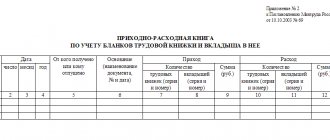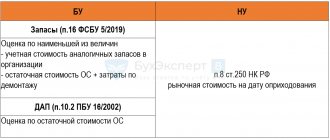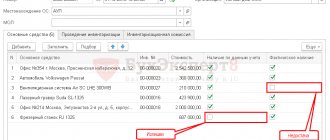Material reserves in budgetary institutions - what is it and how is account 105 formed?
From 01/01/2020, accounting of material inventories in accounting departments is regulated by a new regulatory legal act - the federal standard “Inventories”, which was approved by Order of the Ministry of Finance dated 12/07/2018 No. 256n.
The Ministry of Finance explained detailed guidelines on the application of this standard. You can get acquainted with the point of view of officials in ConsultantPlus. If you do not have access to the K+ system, get a trial online access for free.
Also, as before, in 2022 - 2022 it is necessary to use budget plans of accounts: single (approved by order of the Ministry of Finance dated December 1, 2010 No. 157n) and private (including order of the Ministry of Finance of Russia dated December 16, 2010 No. 174n).
For more information about the regulatory documents governing accounting in budgetary structures, read the article “Rules for maintaining accounting in budgetary organizations.”
So, according to the new standard, starting from 2022, stocks are divided into two groups:
1. Inventory itself:
- materials;
- finished products and biological products;
- goods;
- other materiel values.
2. Work in progress - costs for the manufacture of finished products, performance of work, provision of services attributable to products that have not completed all stages of the technological process, as well as to incomplete products that have not passed testing and technical acceptance, and (or) to the volume of work not completed. (stages of work), services. Accounting for work in progress as part of inventories is an innovation of the Federal Accounting Standards under consideration.
The rules established by the “Reserves” standard do not apply to:
- library collections;
- living organisms that are a source of biological products, the growth and restoration of which are managed and controlled by the accounting entity;
- assets constituting cultural heritage;
- financial instruments;
- work in progress, if the institution that formed it acts as a contractor.
They have their own FSBU.
The chart of accounts (order No. 157n) provides for a synthetic account 010500000 (105) “Inventories” for inventory accounting. The account number 105 itself, where material reserves in a budgetary institution are reflected, consists of 26 digits, but only digits 18–26 are used in the accounting of the institution. Depending on the group and type of inventory and the nature of their movement, the code in digits 22–26 changes in the account number.
Below we consider the scheme for generating an accounting account number in a budgetary organization, and also decipher the category codes using an example. A detailed explanation of the categories can also be found in clause 21 of the Instructions for the chart of accounts (order No. 157n), in the table of the chart of accounts for budgetary institutions and in clause 2.1 of the Instructions for this chart of accounts (order No. 174n).
| Account digit number | ||||
| 18 | 19–21 | 22 | 23 | 24–26 |
| Financial support | Accounting object | Accounting object group | Type of accounting object | Type of receipts, disposals of an accounting object |
| Example, account 110532340 “Increase in the cost of food products - other movable property of the institution” | ||||
| 1 | 105 | 3 | 2 | 340 |
| 1 - at the expense of the budget | 105 - inventories | 3 - other movable property | 2 - food | 340 - increase in cost |
To account for work in progress, account 109 is used. We will not consider the work in progress in this article. The nuances of reflecting transactions with finished products and goods are also not discussed in the article.
For information on how a budgetary institution accounts for fixed assets, read the material “Budget accounting of fixed assets in 2020 - 2022 (nuances).”
Forms of primary documents, including materials accounting, as well as accounting registers and reporting for public sector employees, can be found in ConsultantPlus. Get trial access to the system for free and go to the directory.
Budget accounting entries with examples of basic transactions
Accounting in budgetary organizations has a number of features that differ from the accounting procedure in industrial and commercial enterprises. These include the availability of approved cost estimates and control of their execution, and the use of budget classification, which is the basis for organizing accounting in the institution.
The accounting procedure in budgetary institutions has its own characteristics and specifics. In this article we will introduce you to the main accounting operations of budgetary institutions and the mechanism for reflecting them.
Accounting for receipt of materials
Sources of materials according to the standard are:
- acquisition;
- receipt from other organizations;
- creation for use in one’s own activities;
- production for alienation (sale).
The institution chooses the unit of accounting for inventories independently. These may be (clause 8 of the Federal Budgetary Accounting Standards “Reserves”):
- nomenclature (register) units;
- batches, homogeneous (registry) inventory groups. In this case, analytical accounting of inventories must be ensured, the procedure for maintaining which is prescribed in the accounting policy.
If reserves that can be used for more than 12 months are taken into account, the institution (special commission) must determine their useful life.
Materials are received by institutions on the basis of primary documents at original cost (before the new Federal Accounting Standards came into force, assessments were required to be made at actual cost). The procedure for calculating the initial cost depends on the method of receipt of assets and is described in detail in paragraphs. 19-26 FSBU “Reserves”.
Institutions are also required to carry out subsequent revaluation of inventories with the creation of a reserve. The rules are stated in paragraphs. 29-33 FSBU “Reserves”. In some cases, it is possible to reclassify inventories, i.e., transfer them to another group of inventories or even to a different category of assets (for example, in fixed assets). The procedure and conditions are set out in clause 27 of the Federal Accounting Service.
To reflect receipts in the chart of accounts, separate analytical accounts “Material inventories” are allocated, in categories 24–26 of which code 340 is used for each type of materials: 010521340 - 010526340, 010531340 - 010536340, 010538340 (see order No. 174n).
See the table below for the main entries for the receipt of materials; other transactions can be found in clause 34 of the Instructions for the chart of accounts (order No. 174n).
| Wiring | Wiring Description |
| Dt 010500000 “Inventory” (010521340 - 010526340, 010531340 - 010536340, 010538340) Kt 030234730 “Increase in accounts payable for the acquisition of inventories”, 020834660 “Decrease in accounts receivable of accountable persons for the acquisition of inventories” | Purchasing materials |
| Dt 010500000 “Inventory” (010521340 - 010526340, 010531340 - 010536340, 010538340) Kt 030404340 “Internal departmental settlements for the acquisition of inventories” | Transfer of materials from a higher institution |
| Dt 010500000 “Inventory” (010521340 - 010526340, 010531340 - 010536340, 010538340) Kt 010600000 “Investments in non-financial assets” (010624340, 010634340) | Independent production of materials, purchase under a number of contracts (cost of materials, transportation costs, consulting services, etc.) |
Accounting for an institution's inventories: features of recognition (acceptance) of inventories.
According to clause 100 of Instruction No. 157n, inventories are accepted for accounting of an institution's inventories at actual cost. At the same time, clause 13 of the FSBU “Inventories” establishes that assets related to inventories are accepted for accounting of an institution’s inventories at historical cost. Is there a difference between the actual cost and the original cost? Let's get a look.
Let us turn to clause 102 of the instructions, which establishes that the actual cost of inventories acquired for a fee is recognized as follows:
– amounts paid in accordance with the contract to the supplier (seller); – amounts paid to organizations for information and consulting services related to the acquisition of material assets; – customs duties and other payments related to the acquisition of inventories; – remunerations paid to the intermediary organization through which the inventories were purchased, in accordance with the terms of the contract; – other amounts specified in this paragraph.
From the provisions of clause 19 of the FSBU “Inventories” it follows that the initial cost of inventories acquired as a result of exchange transactions or created by the accounting entity is determined in the amount of the investments actually made, named in this clause (similar to those specified in clause 102 of Instruction No. 157n) . Thus, we can conclude that the concepts of “actual cost” of inventories and their “initial cost” are similar. However, here the Standard “Inventories” establishes the features of accepting inventories for accounting, which are not contained in Instruction No. 157n, but which, of course, need to be taken into account. Let's look at them briefly.
Accounting for the institution's reserves.
Please note that if a government contract (agreement) for the supply (purchase) of inventories to an institution provides for a deferred payment for a period exceeding 12 months, then the difference between the cost when paying without a deferred payment and the cost when paying taking it into account is recognized as expenses for the payment of interest, except for cases when such interest is included in the initial cost of inventories in accordance with the requirements provided for by other regulatory legal acts governing accounting and preparation of accounting (financial) statements (clause 15 of the Federal Budgetary Accounting Standards “Inventories”).
Accounting entities that carry out, in accordance with the decision on the centralization of procurement activities, adopted in the manner established by legislation in the field of procurement of goods, works, services by certain types of legal entities, have functions and powers to purchase inventories for the needs of other public sector organizations (actual recipients of purchased goods). material inventories), costs of delivery to central (production) warehouses (bases) and (or) consignees in accordance with the accounting policies established by them are not included in the actual investments made (initial cost) of acquired material inventories and are reflected as expenses attributable to the financial result of the current period.
Here I would like to dwell on the features of determining the initial cost of material inventories specified in the FSBU “Inventories”:
– acquired as a result of non-exchange transactions (clause 22); – received as a result of disassembly, liquidation (disposal) of fixed assets or other property (clause 23); – received by the accounting entity from the owner (founder) or from another public sector organization (clause 24).
Thus, the initial cost of inventories acquired as a result of a non-exchange transaction is their fair value at the date of acquisition, determined by the market price method. When used, the fair value of inventories is calculated based on current market prices or recent transactions involving similar or similar assets without deferred payment.
When determining fair value, documented data on market prices are used, generated by the commission for the receipt and disposal of assets of the accounting entity independently by studying market prices in the public domain in relation to acquired (received) material inventories.
When determining the fair value for the purpose of accepting an inventory item for accounting, the commission for the receipt and disposal of assets of the accounting entity uses data on prices for similar material assets received in writing from manufacturing organizations; information on the price level available from state statistical bodies, as well as in the media and specialized literature, expert opinions (including experts involved on a voluntary basis to work in the commission on the receipt and disposal of assets of the subject of accounting) on the cost of individual (similar ) reserve objects.
If inventories received in a non-exchange transaction cannot be measured at fair value, their cost is estimated based on the cost information provided by the transferor. If the transferring party for some reason did not provide data on the value of the material reserves transferred as a result of a non-exchange transaction, or it is impossible to determine the fair value of the material reserves as of the date of receipt, such assets are reflected as part of the reserves in the conditional valuation “one object - 1 rub. "
If an institution retains materials as a result of disassembly, liquidation (disposal) of fixed assets or other property, then their initial cost is determined as of the date of acceptance for accounting in a manner similar to that provided for in clause 10 of the Federal Budgetary Accounting Standards “Inventories”. At the same time, the expenses of the accounting entity associated with the dismantling (disassembly), liquidation (disposal) of property, as a result of which materials are accepted, as well as the costs of their transportation, sorting, and other similar costs of bringing them into a condition suitable for use, are included in the expenses of the current period and are not taken into account when determining the initial cost of materials.
Inventories received by an accounting entity from the owner (founder) or from another public sector organization are accepted for accounting in the valuation determined by the transferring party (owner (founder)) - at the cost reflected in the transfer documents (clause 24 of the Federal Accounting Standards Service "Inventories" ").
How to write off inventories in a budget institution: write-off procedure
Inventories are written off:
- when they are consumed (used) in the activities of the institution (including in the production of other non-financial assets, alienation of finished products, biological products);
- making a decision to write off state (municipal) property;
- deciding to no longer use the item as inventory and to cease receiving economic benefits from it;
- transfer to another public sector organization;
- sale (donation), exchange, distribution.
- on other grounds provided by law.
The cost of inventories can be written off in two ways:
- at the cost of each unit;
- average cost.
The selected method for the relevant asset or group of assets must be applied consistently throughout the reporting year.
The procedure for disposal of materials is described in detail in paragraphs. 34-41, and the rules for their assessment upon disposal are in paragraphs. 42-43 FSBU “Reserves”.
Let us describe with an example how to write off inventories in a budget institution.
Example
In the school warehouse there are 5 meters of rolled Whatman paper at a price of 150 rubles. per meter, 7 meters of whatman paper at a price of 177 rubles. per meter Additionally, at the beginning of the month, another 10 meters of whatman paper were purchased at a price of 168 rubles. per meter 15 meters of whatman paper were used in a month. Let's determine the average actual cost of 1 meter of whatman paper used and the total amount of costs.
The average actual cost of 1 meter is:
(5 × 150 + 7 × 177 + 10 × 168) / (5 + 7 + 10) = 166.8 rubles.
The total cost of used Whatman paper is:
166.8 × 15 = 2,502 rubles.
To reflect disposal transactions, separate analytical accounts for the “Inventories” account are also used, ending with 440 and indicating a decrease in the cost of the relevant materials.
| Wiring | Wiring Description |
| Dt 040120272 “Consumption of inventories”, 010900000 “Costs of manufacturing finished products, performing work, services” (010960272, 010970272, 010980272, 010990272) Kt 010500000 “Inventories” (010521440 - 010526440, 010531440 - 010536440) | Use of materials in current activities or production |
| Dt 040110172 “Income from operations with assets” Kt 010500000 “Inventories” (010521440 - 010526440, 010531440 - 010536440) | Sale of materials (except for finished products and goods), as well as write-off due to unsuitability, in case of shortage |
| Dt 030404340 “Internal settlements for the acquisition of inventories” Kt 010500000 “Inventories” (010521440 - 010526440, 010531440 - 010536440) | Transfer of materials from the head institution to the subordinate institution |
For information on how materials are accounted for in commercial organizations, read the article “Accounting entries for materials accounting .
Which KVR and KOSGU to use for government procurement
First of all, let’s define: deciphering what KOSGU is in the budget sounds like this: classification of operations of the public administration sector. The numeric code allows you to accurately classify the transaction performed according to its content.
Subsidies (grants in the form of subsidies) for financial support of costs in connection with the production (sale) of goods, performance of work, provision of services, the procedure (rules) for the provision of which do not establish requirements for subsequent confirmation of their use in accordance with the conditions and (or) purposes of the provision
Information about reserves in reporting, the first application of the Federal Accounting Standards “Reserves”
In its reporting regarding reserves, the institution must disclose information (clause 44 of the Federal Budgetary Accounting Standards “Reserves”):
- on the accounting policies adopted for the valuation of inventories, including methods for calculating costs;
- the total book value of inventories by groups of inventories, divided into those accounted for at historical, standard-plan and fair value;
- the amount of inventories recognized as expenses in the reporting period;
- the amount by which the reserve for reducing the cost of supplies is accrued and reduced;
- the carrying value of inventories pledged as security for the fulfillment of obligations.
Institutions must apply the FSBU “Reserves” from 2022. At the same time (paragraphs 45-47 FSBU “Reserves”):
- Accounting items that were not previously considered inventories or are listed on the balance sheet, but meet the criteria for recognition as such an asset as of 01/01/2020, must be reflected on balance sheet accounts at historical cost. If necessary, reclassification or revaluation of inventories recorded before the first application of FAS is carried out.
- The financial result obtained as a result of these operations is reflected at the beginning of the reporting period as an adjustment to the financial result of previous years. The results of such adjustments are disclosed separately in the notes to the accounting (financial) statements.
- Information on receipts and disposals of inventories for years prior to the first application of the standard is not restated.
Since 2022, the updated Chart of Accounts for budget accounting has been applied
Charts of accounts and instructions for state, budgetary and autonomous institutions are brought into compliance with new standards and KOSGU. Technical amendments have been made to them by analogy with the Unified Chart of Accounts and Instruction No. 157n. What should you pay special attention to?
Wiring for government agencies has also been changed. Changes have also occurred in the methodology for budgetary and autonomous institutions. In order to switch to new charts of accounts and instructions, it is necessary to make appropriate changes to the working chart of accounts and the text part of the accounting policy. Incoming balances must be formed during the inter-reporting period. January and February postings for old accounts should be corrected from the current date, as in the previous year.
Results
Accounting in accounting is strictly regulated by regulations. Since 2022, it has been subordinated to the new FSBU “Reserves”. Before you start applying it, you need to analyze the previous accounting rules and make the necessary adjustments.
Sources: Order of the Ministry of Finance of Russia dated December 1, 2010 No. 157n
You can find more complete information on the topic in ConsultantPlus. Free trial access to the system for 2 days.
ACCOUNTING FOR DRESSINGS IN 2022
Dressing materials are fibers, threads, fabrics, films, non-woven materials from which dressings are directly manufactured by enterprises, medical personnel or patients themselves. Dressing materials include cotton wool, gauze, calico, tilexol, etc. A dressing is a medical product made from one or more dressing materials, intended for fixation, absorption, prevention of wound infection and their treatment. Dressings include bandages, plasters, tampons, dressing bags, napkins, medicated sponges and wound film coverings. Dressings are medical products. All names of dressings must be registered in the state register of medical products. According to Article 38 of the Federal Law of November 21, 2021 No. 323-FZ “On the fundamentals of protecting the health of citizens in the Russian Federation,” only those medical devices that are registered in this register are allowed to circulate in Russia. An exception is medical devices that are manufactured according to individual orders of patients, which are subject to special requirements for the appointment of medical professionals and which are intended exclusively for the personal use of a specific patient. That is, from gauze and cotton wool registered in the register, you can make a cotton-gauze bandage for a patient, and this will not be a violation. Section 18 of the decision of the Customs Union Commission dated May 28, 2021 No. 299 approved the requirements for medical products and medical equipment. During operation, medical devices should not create levels of harmful factors (physical, chemical and biological) in the workplace of medical personnel and other users that exceed the maximum permissible levels in accordance with the requirements of sanitary legislation. Products must ensure the safety of the patient, or the safety and health of users, or, where appropriate, other persons, and any risk associated with their use must be acceptable in relation to the benefit to the patient and the level of health and safety provided. For each type of medical device, raw materials and materials for their manufacture, the manufacturer draws up and approves in the prescribed manner normative and technical documentation, including the recipe or composition.
We recommend reading: If the Penalty was not initially collected in the Claim, You Can Add a Penalty Claim to This Claim
In this case, only part of the document is provided for familiarization and avoidance of plagiarism of our work. To gain access to the full and free resources of the portal, you just need to register and log in. It is convenient to work in extended mode with access to paid portal resources, according to the price list.
Analytical accounting registers
| AN OBJECT | ACCOUNTING REGISTERS | PECULIARITIES |
| Types of MH | Cards of quantitative and total accounting | Maintain CMO by name, variety and quantity |
| Food | Cumulative statement of income and expenses, turnover sheet | The turnover sheet is filled out on the basis of the accumulative sheet. Balances are released at the end of the month |
| Broken dishes | Registration book | Lead by CMO |
| Young animals, fattening animals | Ledger | By species and age groups (young animals only) |
Medicines are under control
Narcotic drugs, psychotropic substances and their precursors are released to departments in accordance with paragraph 3 of paragraph 4 of Decree of the Government of the Russian Federation of December 31, 2022 No. 1148 “On the procedure for storing narcotic drugs, psychotropic substances and their precursors.”
After making changes to the procurement plan with the corresponding reflection in the schedule, the institution holds tenders and purchases this product at a price of 112,000 rubles per piece. When returning borrowed goods, the following entries are made in accounting:







